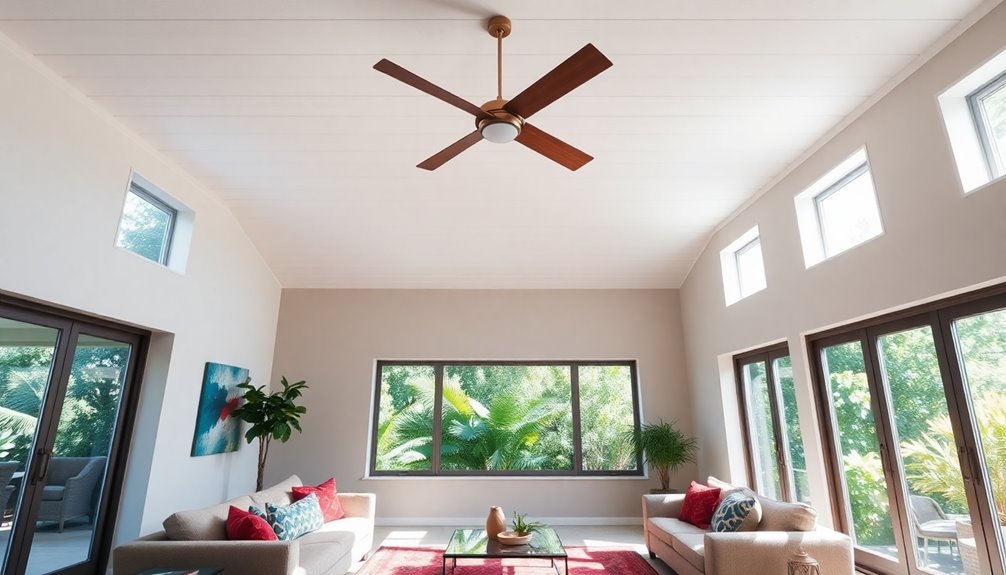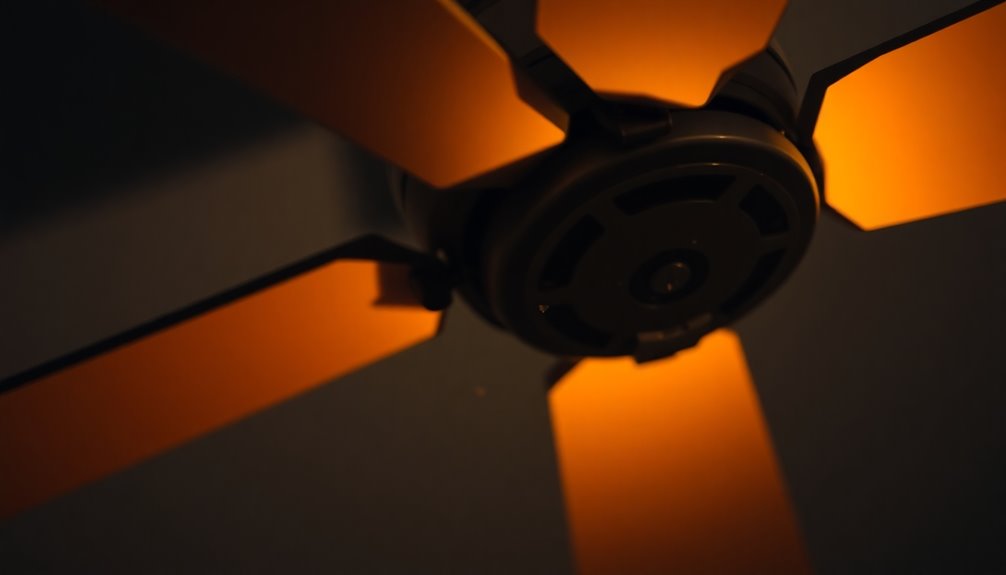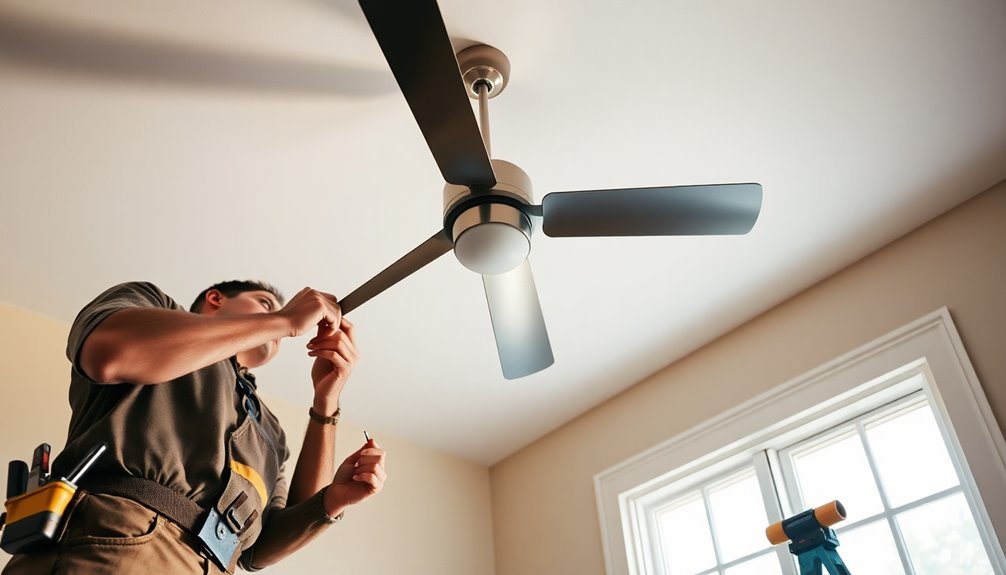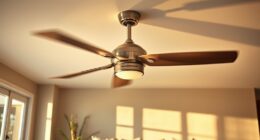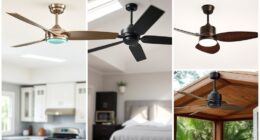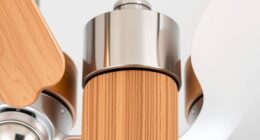The blue wire on a ceiling fan is used to power the light kit, giving you the ability to control the light separately from the fan. It typically connects to the ceiling's hot wire and plays an important role in your fan's functionality if you're using a light kit. If there's no light kit installed, make sure to cap off the blue wire to avoid any electrical problems. Understanding how to properly connect this wire is essential for safe operation and best performance. There's plenty more to discover about wiring setups and troubleshooting tips!
Key Takeaways
- The blue wire powers the light kit in ceiling fans, allowing independent control of the light and fan motor.
- It connects to the ceiling's hot wire for light functionality when a light kit is installed.
- If no light kit is present, the blue wire must be capped off to prevent electrical issues.
- The blue wire is essential for fans with separate controls, ensuring optimal user experience.
- Proper wiring and adherence to color codes are critical for safe and effective installation.
Purpose of the Blue Wire

The blue wire in a ceiling fan plays an essential role in powering the light kit. This wire acts as a power source for the light, allowing you to control it independently from the fan motor. When you install a light kit, the blue wire connects to the ceiling's hot wire, enabling the light's functionality while the black wire supplies power to the fan motor.
If you choose to install a ceiling fan without a light kit, you might find the blue wire capped off and unused, as it's unnecessary for the fan's operation alone. However, if your ceiling fan features both a fan and light function, the blue wire becomes critical. It guarantees you can control the light through a switch or remote control, enhancing your overall experience.
To make sure everything operates correctly and safely, proper identification and connection of the blue wire are essential. Mistakes in wiring can lead to malfunctioning lights or even electrical hazards.
Common Wire Color Codes

When working with ceiling fans, it's important to familiarize yourself with common wire color codes to guarantee a safe and effective installation. The blue wire is a key component, typically controlling the light kit. This allows for independent operation of the light and fan, giving you flexibility in how you use them.
In most wiring configurations, the blue wire connects to the hot wire from the ceiling, which provides power to the light fixture. If you're not installing a light kit, you can simply cap off the blue wire and leave it unused.
In some instances, the blue wire might connect to the same wire as the black wire when a light is present, assuring proper functionality.
Understanding these common wire color codes helps you navigate the various wiring connections necessary for a ceiling fan installation. This knowledge is essential for making certain safe operation and preventing any mishaps. Additionally, ensuring proper color accuracy in your home lighting can enhance the overall ambiance.
Always double-check your wiring configurations and verify the blue wire is connected correctly to maintain the effective performance of both the fan and light kit.
Wiring Connections Explained

When you're wiring your ceiling fan, understanding the blue wire's functionality is essential for controlling the light kit.
You'll want to follow the wiring diagram specific to your model to guarantee proper connections. Knowing common wiring configurations will help you avoid mistakes and make certain everything operates smoothly.
Blue Wire Functionality
In modern ceiling fans equipped with light fixtures, the blue wire plays an essential role in controlling the light independently from the fan itself. This functionality allows you to enjoy customized lighting without adjusting the fan speed or vice versa. When you connect the blue wire during your wiring connections, it typically hooks up to the ceiling's blue or black wire if a light kit is present, making certain the light receives power when the fan operates.
Here's a quick overview of the blue wire functionality:
| Feature | With Light Kit | Without Light Kit |
|---|---|---|
| Connection | Connects to ceiling's blue/black | Cap off the blue wire |
| Independent Operation | Yes | Not applicable |
| Remote Control | Connects to light control receiver | Not needed |
Always remember to follow the manufacturer's instructions for your specific ceiling fan model. The blue wire's role can vary depending on design features, especially when using remote control options. Understanding this guarantees proper installation and ideal performance of your fan and light fixture.
Wiring Diagram Overview
Understanding the wiring diagram for your ceiling fan is essential for a successful installation. The blue wire plays a critical role in connecting the light kit to the power source. In a typical wiring setup, you'll connect the blue wire to the corresponding blue or black wire from the ceiling. This guarantees the light functions independently of the fan, allowing for efficient operation.
The black wire is responsible for powering the fan motor, while the blue wire handles the electrical flow to the light fixture. If your ceiling fan lacks a light kit, you should cap off the blue wire with a wire nut to avoid potential electrical issues.
When you refer to the wiring diagram, pay close attention to correctly identify and connect the blue wire. Proper wiring not only enhances the functionality of your ceiling fan but also assures safety during operation. Additionally, ensuring that your home has good air quality can further improve the overall ambiance while enjoying your ceiling fan's features.
Always double-check your connections before powering on the fan to prevent any mishaps. By following these guidelines, you'll set up your ceiling fan and light kit correctly, maximizing their performance and longevity.
Common Wiring Configurations
Various wiring configurations exist for ceiling fans, and knowing how to connect the wires correctly is essential for guaranteeing everything works as intended. The blue wire typically controls your light fixture, allowing for separate operation from the fan. In most setups, you'll connect the blue wire to the hot wire, often the black wire in your ceiling.
Here are some common wiring configurations to take into account:
- With a Light Kit: Connect the blue wire to the black wire for proper light operation.
- Without a Light Kit: Cap off the blue wire to prevent electrical issues.
- Multiple Switches: Confirm each switch corresponds correctly to the fan and light for seamless operation.
- Reversed Polarity: Double-check connections to avoid wiring mishaps that can affect performance.
Understanding these configurations is vital for a safe and effective installation.
Always remember that improperly connecting the blue wire can lead to electrical issues, impacting both the light fixture and fan's operation.
Wiring With a Light Kit

When you're wiring a ceiling fan with a light kit, the blue wire plays an essential role in controlling the light separately from the fan.
You'll want to connect this blue wire to the hot wire from the ceiling to guarantee proper functionality.
Always check the manufacturer's wiring diagram for guidance to avoid any issues during installation.
Blue Wire Functionality
The blue wire in a ceiling fan is vital for connecting the light kit, allowing you to control the light independently from the fan. This wire acts as the power source for the light, and proper wiring is essential for functionality. To guarantee everything works seamlessly, connect the blue wire to the hot wire from the ceiling that controls the light.
Here are a few reasons why understanding the blue wire is important:
- Independent control: You can turn the light on or off without affecting the fan.
- Enhanced comfort: Adjust lighting based on your mood without adjusting the fan speed.
- Prevention of electrical issues: Capping off the blue wire when no light kit is installed avoids potential short circuits.
- Improved aesthetics: Use the light to highlight your room's decor.
When you wire your ceiling fan with a light kit, make sure you identify and connect the blue wire correctly. This attention to detail guarantees the light operates properly, making your space more functional and enjoyable.
Wiring Connections Explained
Understanding how to connect the blue wire sets the stage for wiring your ceiling fan with a light kit effectively. The blue wire typically serves as the hot wire for the light kit, allowing you to control the light independently from the fan. To establish proper wiring connections, connect the blue wire from your ceiling fan to the corresponding blue or black wire from the ceiling, which provides the necessary power source for the light.
If you aren't installing a light kit, cap off the blue wire to avoid confusion and potential short circuits. For fans designed with separate controls for the light and fan, the blue wire is essential for ensuring functionality, as it links the light kit to the power source.
When making these connections, always use wire nuts to secure the blue wire and any other connections. This not only prevents exposure but also enhances safety during operation.
Light Kit Compatibility
While selecting a ceiling fan with a light kit, it's important to guarantee compatibility between the fan and the light components. The blue wire plays a vital role in this setup, as it connects directly to the light kit, allowing you to control the light independently from the fan.
To make sure everything works smoothly, follow these guidelines:
- Always connect the blue wire from the fan to the power source for the light, typically the ceiling's blue or black wire.
- If you opt not to install a light kit, cap off the blue wire to avoid any electrical issues.
- Remember, incorrect wiring can prevent the light kit from functioning properly.
- Confirm the light switch activates the blue wire's functionality for seamless operation.
Wiring Without a Light Kit

When installing a ceiling fan without a light kit, you'll find that the blue wire, which usually controls the light, can simply be capped off and left unused. In this setup, the black wire serves as the main power source for the fan motor. Connect this black wire to the corresponding hot wire from your ceiling to guarantee the fan receives power.
Next, you'll need to deal with the white wire. This wire functions as the neutral wire, and it should connect to the ceiling's neutral wire to complete the circuit.
Don't forget about safety; the green or copper ground wire must be connected to the ceiling electrical box to prevent any electrical hazards.
Once you've made all the necessary connections, make sure to secure them with wire nuts. This helps prevent exposure and potential electrical issues in the future.
Double-check each connection to confirm they're tight and secure, giving you peace of mind that your ceiling fan is wired correctly and ready for use. By following these steps, you'll have a fully functional ceiling fan without needing to worry about any light kit connections.
Troubleshooting Wiring Issues

After setting up your ceiling fan without a light kit, you might encounter some wiring issues that need troubleshooting. Don't worry; these problems are usually straightforward to fix.
First, verify that the blue wire is correctly connected. This wire typically controls the light fixture, allowing for separate operation of the fan and light.
Here are some common troubleshooting steps you might consider:
- Verify the blue wire connection to the corresponding ceiling wire, usually the black wire.
- Check if the fan operates but the light does not; this often means an issue with the blue wire.
- Examine the power source to confirm it supplies the necessary electricity.
- Consult the installation manual for specific wiring diagrams that can clarify any confusion.
If the blue wire isn't connected to a light kit, cap it off to avoid any electrical issues.
By following these guidelines, you can effectively troubleshoot your ceiling fan's wiring issues and confirm everything is functioning as it should.
Safety Tips for Installation

Before diving into your ceiling fan installation, it's vital to gear up for safety. Start by turning off the power at the circuit breaker to prevent any electrical shock. Always use a voltage tester to confirm that the power is off before handling any wires or components. Wearing safety goggles and rubber gloves is significant when working with electrical wiring to protect yourself against potential hazards.
Here's a quick reference table to keep you on track:
| Safety Tip | Description | Importance |
|---|---|---|
| Turn Off Power | Switch off the circuit breaker before starting | Prevent electrical shock |
| Use Voltage Tester | Confirm no power is present | Guarantee safety |
| Wear Safety Goggles & Gloves | Protect against debris and electrical hazards | Personal protection |
| Check Local Electrical Codes | Follow regulations for safe installation | Compliance with standards |
Make sure your ceiling fan is hung at least 8 feet above the floor to comply with safety standards and avoid obstructions. Familiarize yourself with local electrical codes to ascertain your installation meets all safety requirements. Additionally, consider implementing advanced cleaning features to enhance your overall safety and hygiene during the installation process. Prioritize these safety tips for a successful and secure ceiling fan installation.
Frequently Asked Questions
What Does a Blue Wire Connect To?
When you're dealing with electrical wiring, knowing what each wire connects to is essential.
A blue wire typically connects to the power source for your light fixture. If you've got a light kit, it'll link to the ceiling's blue wire, giving you independent control over the light.
If there's no light kit, you can cap it off. Always double-check connections to verify everything works safely and properly during installation.
Do Blue and Black Fan Wire Go Together?
When you're wiring a ceiling fan, you might wonder if the blue and black wires go together.
It's an essential question, and the answer depends on your setup. If you're connecting a light kit, they often work in tandem, allowing you to control both the fan and light independently.
But if your fan doesn't have lights, the blue wire might just sit unused.
Always check your manufacturer's wiring diagram to be sure!
What Is the Blue Wire Coming From the Ceiling?
The blue wire coming from the ceiling usually serves a specific purpose in your electrical setup.
It often connects to lighting fixtures, allowing you to control lights independently from the fan. If you don't have a light kit, you can simply cap it off, as it won't affect the fan's operation.
Always guarantee you identify it correctly during installation to prevent any confusion or electrical issues.
Safety's key when working with wiring!
Do You Need 2 Wire or 3 Wire for Ceiling Fan?
You'll need two wires for a basic ceiling fan setup, which includes a hot wire and a neutral wire.
However, if your fan has a light fixture, you should use three wires. This allows you to control the fan and the light independently.
For remote-controlled fans, you might need even more wires to connect the receiver.
Conclusion
In summary, understanding the blue wire on a ceiling fan is essential for a successful installation. Did you know that about 70% of homeowners attempt DIY electrical projects? Keeping safety in mind while wiring can save you from potential hazards and costly mistakes. Whether you're connecting a light kit or not, knowing how to handle the blue wire can make all the difference. So, don't hesitate—get informed and tackle that ceiling fan project with confidence!


